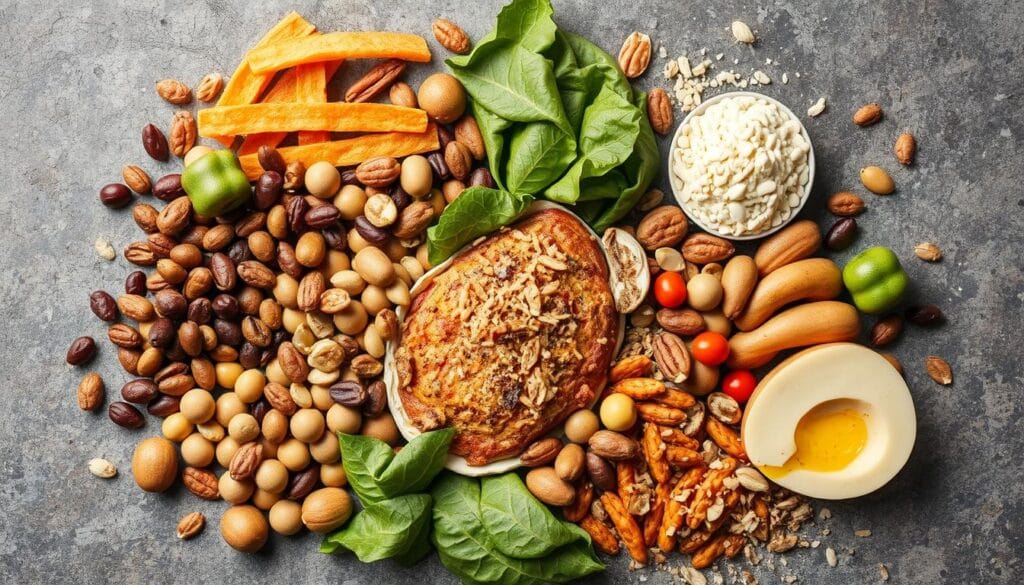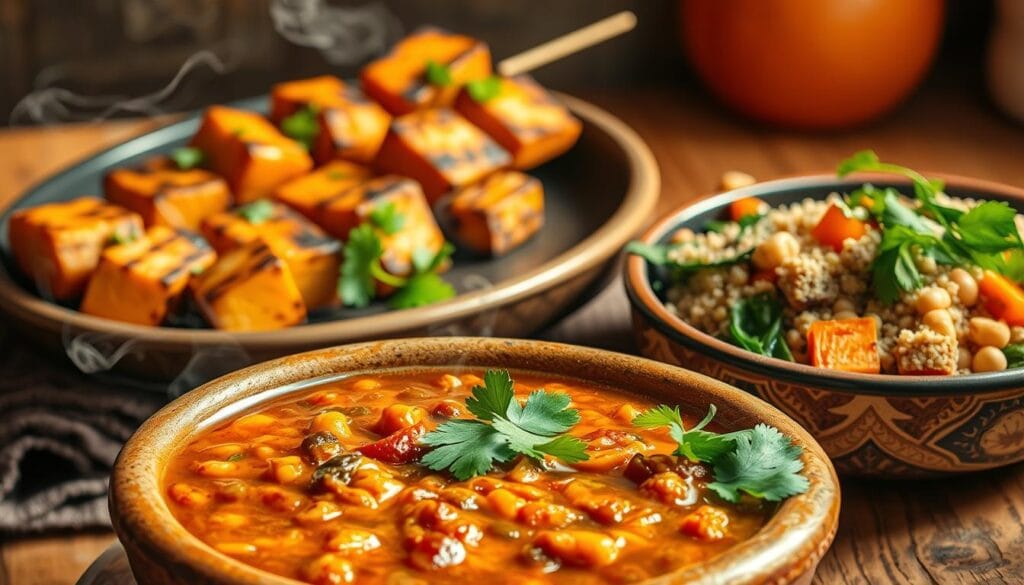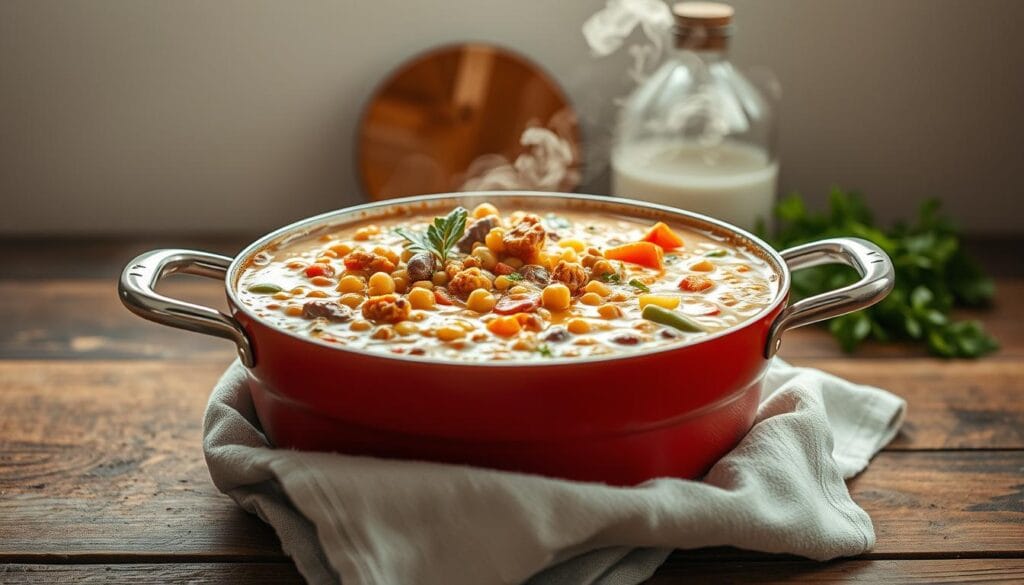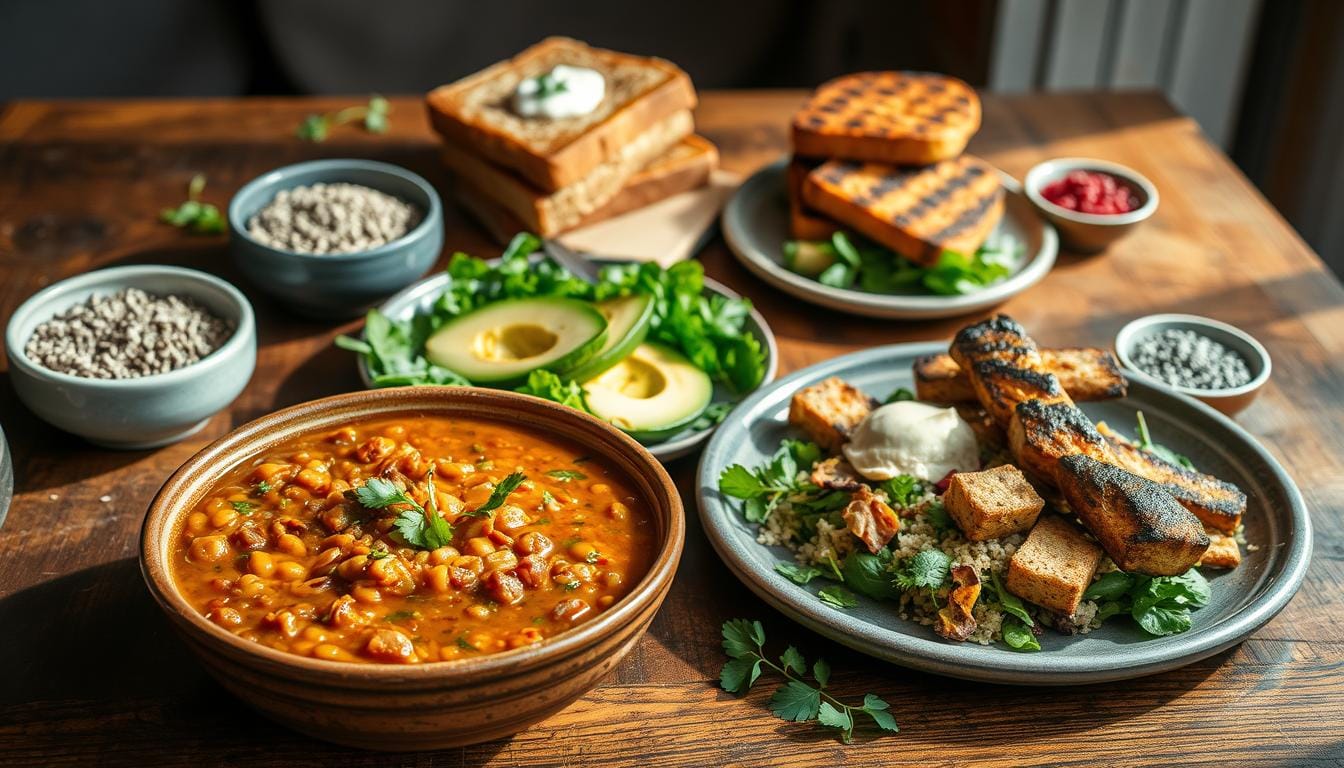Quick Vegan High Protein Meals to Fuel You
Are you one of those who believe that a plant-based diet can’t provide enough protein to build muscle? You’re not alone. Many people share this misconception. When I transitioned to a vegan lifestyle, I was uncertain about where my protein would come from. However, I’ve since discovered that it’s not only possible but also easy to prepare high protein meals that are both delicious and quick.
Imagine having a variety of protein-rich ingredients at your disposal, forming the foundation of satisfying meals that fuel your body. This article will explore how to incorporate these ingredients into your daily routine, debunking common myths about vegan diets and showcasing quick vegan meals that meet your nutritional needs.
Table of Contents
The Power of Plant-Based Protein
With the right knowledge, you can fuel your body with high-quality plant-based protein. As you explore vegan high protein meals, understanding the power of plant-based protein is crucial. It’s not just about consuming enough protein; it’s about optimizing your overall health and fitness goals.
Common Misconceptions About Vegan Protein
Many believe that vegan diets lack sufficient protein, but this is a common misconception. In reality, a well-planned vegan diet can provide more than enough protein. As noted by a prominent nutrition expert, “A varied vegan diet that includes legumes, nuts, and seeds can easily meet your daily protein needs.”
How Much Protein Do You Actually Need?
Your protein requirements vary based on factors such as age, weight, activity level, and fitness goals. For instance, the general recommendation for sedentary adults is about 0.8 grams of protein per kilogram of body weight daily. However, athletes or those engaged in regular strength training may need 1.2-2.0 grams of protein per kilogram of body weight. Spreading your protein intake throughout the day can optimize muscle protein synthesis.
- Older adults often benefit from higher protein intake to prevent age-related muscle loss.
- During periods of caloric restriction, higher protein intake helps preserve lean muscle mass.
Most Americans consume more protein than they need, making the transition to plant-based sources straightforward. The quality of protein matters as much as quantity, with diverse plant sources providing a complete amino acid profile.
Top Protein Sources for Vegan High Protein Meals
When it comes to vegan high protein meals, knowing the top protein sources is crucial for a balanced diet.

Legumes: The Protein Powerhouses
Legumes are among the highest protein-containing foods in a vegan diet. They are versatile and can be incorporated into a variety of dishes, from soups to salads.
Tofu, Tempeh, and Other Soy Products
Tofu, tempeh, and other soy products are excellent sources of protein and can be easily integrated into meals. They are highly versatile and can be marinated, baked, or stir-fried.
Nuts, Seeds, and Their Butters
Nuts and seeds, along with their butters, provide a significant amount of protein. Almonds, chia seeds, and hemp seeds are particularly high in protein.
Whole Grains with Surprising Protein Content
Certain whole grains are surprisingly high in protein. For example, quinoa contains about 8 grams of protein per cooked cup and is one of the few plant foods with a complete amino acid profile. Other grains like amaranth, spelt, and teff also offer a significant amount of protein.
- Quinoa contains about 8 grams of protein per cooked cup and is one of the few plant foods with a complete amino acid profile.
- Amaranth provides 9 grams of protein per cooked cup and can be used in porridges, salads, or as a side dish.
- Spelt offers 11 grams of protein per cooked cup and can be used in place of rice or in grain bowls.
- Teff, a tiny ancient grain, contains 10 grams of protein per cup and works well in porridges and baked goods.
- Many whole grains cook quickly, especially when using methods like the Instant Pot or pressure cooker.
- Combining grains with legumes creates traditional protein-rich combinations found in cuisines worldwide.
- Whole grains provide sustained energy due to their complex carbohydrates and fiber content, complementing their protein value.
20-Minute High-Protein Vegan Breakfast Options
Kickstart your day with a nutritious and filling vegan breakfast that’s high in protein. You can easily prepare these meals in under 20 minutes, making them perfect for busy mornings. Incorporating protein-rich foods into your breakfast routine can help sustain your energy levels and support overall health.
Protein-Packed Edamame Toast (30g Protein)
Edamame toast is a simple yet satisfying breakfast option that packs a significant protein punch. With 30 grams of protein, it’s an excellent way to start your day. The combination of edamame and whole grain bread provides a boost of protein and complex carbohydrates.
Ingredients and Preparation
To make edamame toast, you’ll need cooked edamame, whole grain bread, garlic, lemon juice, and olive oil. Simply toast the bread, mash the garlic, and top with edamame. Drizzle with lemon juice and olive oil for added flavor.
Protein Breakdown and Nutritional Benefits
The edamame is the primary source of protein in this dish, providing approximately 17 grams per 1 cup cooked. Whole grain bread adds additional protein and fiber, making this a nutritious and filling breakfast option. As Mark Hyman, M.D. once said,
“The food you eat can either be the safest and most powerful form of medicine, or the slowest form of poison.”
Quick Chickpea Flour Frittata (16g Protein)
A chickpea flour frittata is a versatile and protein-rich breakfast option that’s easy to prepare. With 16 grams of protein per serving, it’s an excellent alternative to traditional egg-based frittatas.
Ingredients and Preparation
To make a chickpea flour frittata, you’ll need chickpea flour, water, nutritional yeast, and your choice of vegetables. Mix the chickpea flour with water to create a batter, then add nutritional yeast and chopped vegetables. Pour the mixture into a greased skillet and cook until set.
Protein Breakdown and Nutritional Benefits
- Each serving (2 slices) provides 16 grams of protein, primarily from chickpea flour.
- Chickpea flour contributes approximately 12 grams of protein per serving.
- Nutritional yeast adds about 2 grams of protein per serving and provides a complete amino acid profile.
- Added vegetables contribute small amounts of protein along with fiber, vitamins, and minerals.
The chickpea flour frittata is not only high in protein but also rich in complex carbohydrates and fiber, making it a nutritious and satisfying breakfast choice. With its moderate fat content from olive oil, it supports the absorption of fat-soluble vitamins.
Satisfying Lunch and Dinner Vegan High Protein Meals
You can enjoy a variety of satisfying and protein-rich vegan meals for lunch and dinner. These meals are not only delicious but also packed with nutrients to keep you energized throughout the day.
Five-Spice Tofu Noodles (37g Protein)
Five-Spice Tofu Noodles are a flavorful and nutritious option, providing 37 grams of protein per serving. This dish combines the savory taste of five-spice with the protein-rich goodness of tofu.
Ingredients and Preparation
To prepare Five-Spice Tofu Noodles, you’ll need ingredients like firm tofu, five-spice powder, noodles, and various vegetables. Start by marinating the tofu in a mixture of soy sauce, five-spice powder, and other spices, then pan-fry until crispy. Cook the noodles according to the package instructions and combine with the tofu and vegetables.
Protein Breakdown and Nutritional Benefits
The tofu in this dish is the primary source of protein, contributing approximately 20 grams per serving. Additional protein comes from the vegetables and noodles. This meal is not only high in protein but also rich in fiber and various vitamins.
Quinoa Lentil Bowl with Garlicky Pepitas (33g Protein)
The Quinoa Lentil Bowl with Garlicky Pepitas is another nutritious option, offering 33 grams of protein per serving. This bowl is a perfect blend of quinoa, lentils, and pepitas, making it a complete protein source.
Ingredients and Preparation
To make this bowl, you’ll need quinoa, lentils, pepitas, garlic, and various spices. Start by cooking the quinoa and lentils separately, then prepare the garlicky pepitas by roasting them with garlic and olive oil. Combine all the ingredients in a bowl and season with your favorite spices.
Protein Breakdown and Nutritional Benefits
The combination of quinoa and lentils provides a complete protein source, contributing to the high protein content of this dish. Pepitas add additional protein along with healthy fats. This meal is rich in fiber, vitamins, and minerals, making it a nutritious choice.
High-Protein Vegan “Marry Me Pasta” (38g Protein)
This High-Protein Vegan “Marry Me Pasta” is an impressive dish, providing 38 grams of protein per serving. It’s a creamy and satisfying pasta dish that’s sure to become a favorite.
Ingredients and Preparation
To prepare this pasta, you’ll need red lentil pasta, butter beans, nutritional yeast, soy milk, cashews, and various spices. Cook the pasta according to the package instructions, then blend the sauce ingredients together until creamy. Combine the cooked pasta with the sauce and top with additional nutritional yeast and cashews if desired.
Protein Breakdown and Nutritional Benefits
- This pasta dish provides an impressive 38 grams of protein per serving, making it one of the highest protein vegan meals.
- Red lentil pasta serves as the primary protein source, contributing approximately 20-22 grams of protein per serving.
- Butter beans add approximately 7-8 grams of protein per serving while providing a satisfying texture.
- Nutritional yeast contributes 4-5 grams of protein per serving along with B vitamins.
- Soy milk adds 4-5 grams of protein per serving while creating creaminess in the sauce.
- Cashews provide 2-3 grams of protein per serving along with healthy fats that enhance flavor and nutrient absorption.
- With 18 grams of fiber per serving, this dish supports digestive health and promotes satiety.
- The meal contains 11mg of iron per serving, addressing a nutrient of concern for many following plant-based diets.
Nutrition Information Per Serving/Portion: Calories 620kcal | Carbohydrates 88g | Protein 38g | Fat 10g | Sodium 374mg | Fiber 18g | Vitamin A 339IU | Vitamin C 115mg | Calcium 171mg | Iron 11mg

One-Pot Protein-Rich Vegan Soups and Stews
Vegan soups and stews cooked in one pot are a great way to increase your protein intake while enjoying a hearty and comforting meal. These dishes are perfect for busy days when you need a nutritious meal without spending too much time in the kitchen.

Hearty Lentil Vegetable Soup (19g Protein)
The Hearty Lentil Vegetable Soup is a prime example of a protein-rich vegan soup that can be easily prepared in one pot. This soup is not only delicious but also packed with nutrients.
Ingredients and Preparation
To make this soup, you’ll need lentils, a variety of vegetables, and some aromatic spices. Simply sauté the vegetables, add the lentils and broth, and let it simmer until the lentils are tender. This recipe is straightforward and requires minimal supervision.
Protein Breakdown and Nutritional Benefits
This soup provides approximately 19 grams of protein per serving, primarily from the lentils. Lentils are a great source of protein and fiber, making this soup very filling. It’s also low in fat, making it a healthy option for those watching their diet.
Moroccan Lentil Soup (21g Protein)
Another excellent option is the Moroccan Lentil Soup, which offers 21 grams of protein per serving. This flavorful soup is made with red lentils, vegetables, and a blend of warming spices.
Ingredients and Preparation
The ingredients for Moroccan Lentil Soup include red lentils, onions, garlic, ginger, and a mix of spices. The preparation involves sautéing the aromatics, adding the lentils and broth, and simmering until the lentils are cooked. You can serve it with whole grain pita bread for a complete meal.
Protein Breakdown and Nutritional Benefits
The red lentils in this soup are the main source of protein, contributing about 18-19 grams per serving. The vegetables add additional protein, bringing the total to 21 grams per serving. This soup is not only high in protein but also rich in fiber and iron, thanks to the combination of lentils and tomatoes.
Both of these soups are excellent examples of how one-pot vegan meals can be both nutritious and delicious, providing a good amount of protein per serving while being low in fat.
Conclusion: Fueling Your Body with Plant-Based Protein
As we’ve explored throughout this article, vegan high protein meals offer a delicious and nutritious alternative to traditional protein sources. The recipes shared provide between 16-38 grams of protein per serving, comparable to many animal-based protein meals.
By combining different plant protein sources, you can create meals with complete amino acid profiles that support muscle building and recovery. Ingredients like tofu, lentils, beans, and whole grains showcase the versatility of plant-based eating.
These high-protein vegan meals are not only rich in protein but also in fiber, vitamins, minerals, and phytonutrients that support overall health. Many of these recipes can be prepared in 30 minutes or less, making them practical for everyday cooking.
By incorporating these vegan high protein meals into your routine, you can fuel your body effectively while enjoying delicious food. Whether you’re fully plant-based or looking to incorporate more plant proteins into your diet, these recipes provide accessible starting points.
FAQ
What are some quick and easy ways to incorporate more plant-based protein into my diet?
You can start by adding lentils, tofu, or tempeh to your meals, or by using nut butters like peanut butter as a sauce or a dip. You can also sprinkle seeds like chia or hemp on your salad or oatmeal.
How much protein do I need per serving in a meal?
The amount of protein you need per serving varies based on your individual needs, but a general guideline is to aim for 15-30 grams of protein per meal. You can achieve this by combining different plant-based protein sources like legumes, whole grains, and nuts.
Can I get enough protein from a single plant-based food?
While some plant-based foods like lentils and tofu are high in protein, it’s often easier to meet your protein needs by consuming a variety of foods. You can also consider using quinoa, a whole grain that is a complete protein source.
How can I make high-protein vegan meals in under 20 minutes?
You can make quick and easy meals by using pre-cooked lentils or tofu, and by keeping a stash of canned beans and nuts on hand. Simply sauté some garlic and olive oil, add your protein sources, and serve over quinoa or pasta.
Are vegan meals suitable for meal prep?
Yes, vegan meals are perfect for meal prep. You can cook a big batch of lentil soup or quinoa salad on the weekend and portion it out for the week. Simply reheat or assemble your meals as needed.

